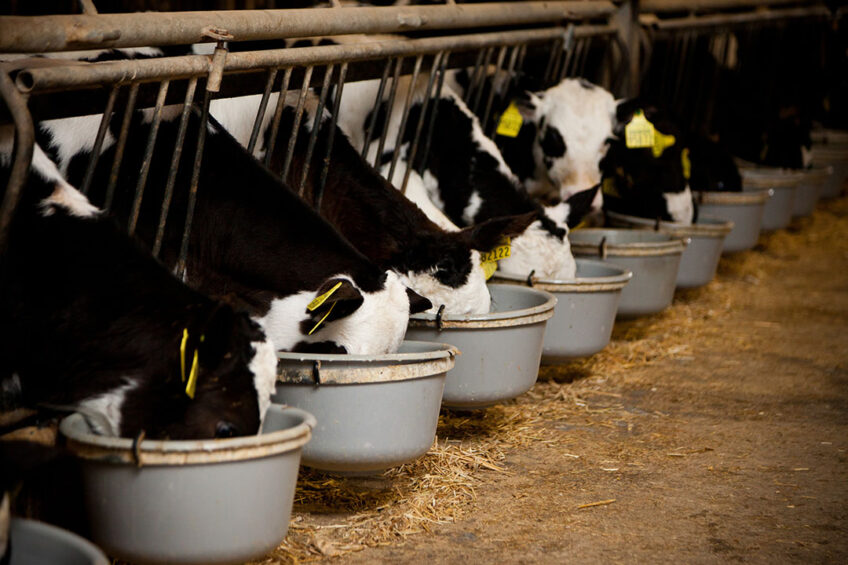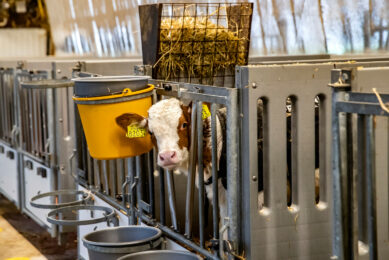Probiotics and its impact on calf gut health

Diarrhoea in calves occurs at approximately 2 weeks of age and is often linked with gut microbiota disorder and damage to the gut mucosal barrier. According to the U.S. Department of Agriculture, annual calf diarrhoea mortality rate is up to 25% in the US.
Calf diarrhoea leads to tremendous economic loss due to high mortality rate, treatment and labour costs, lower growth performance, and breeding cost. Therefore, it is essential to effectively prevent and control diarrhoea in calves by improving gut health.
Role of gut microbiota
Gut microbial composition in pre-weaning calves affects their health and growth performance. Gut microbiota has several functions such as carbohydrate and fibre degradation, dietary lipid intake and deposition regulation, vitamins and short-chain fatty acids production, immune system stimulation, gut movement control, and host protection from gut pathogens.
In newborn calves, various microorganisms from the external environment enter and colonise in the digestive tract and any disfunction in gut absorption, movement, and secretion disturbs gut microbiota. When the gut microbial barrier is breached, many enteric pathogens such as bacteria and viruses colonise the gut and cause inflammation and then diarrohea.
Probiotics
Probiotics are living microorganisms including bacteria and yeast that are supplemented in adequate amounts to improve gut health and decrease the incidence of diarrohea in calves. In the next section the impacts of yeast products and bacterial-based probiotics will be discussed.
Impact of yeast products
Yeast products prevent microbial imbalances and augment microbial activity in calves which, in turn, reduce the incidence and severity of diarrhoea. Available yeast products on the market include live yeast (fermentable living yeast that are dried) and yeast cultures (products of yeast fermentation that include the media they are grown in).
Supplementation of yeast products in pre-weaning phase promotes optimal maturation of the rumen microbiota, increases starter intake, average daily gain, and faecal consistency, modulates gut mucosal immunity, and reduces the risk of pathogen colonisation.
The most extensively used probiotic strain of yeast for farm animals is Saccharomyces cerevisiae, which stabilises rumen pH and increases cellulolytic bacteria growth in the early rumen conditions. Calves supplemented with Saccharomyces cerevisiae show no drop in weight gain during a diarrheic episode.
Moreover, supplementation of Saccharomyces cerevisiae to calves with failed transfer of passive immunity improve performance and decrease diarrhoea duration. Supplementing yeast culture in starter feed increase the abundance of Butyrivibrio and decrease Presvotella richness in rumen fluid, thus enhancing butyrate production, papillae length, and rumen weight.
Yeast culture improves gut development through increased villus height and villus height-to-crypt ratio in all segments of the small intestine, and increased villi length and crypt depth in the ileum. Furthermore, yeast culture increases gut barrier integrity and reduces infiltration of toxic luminal antigens and bacteria.
Supplementation of Saccharomyces cerevisiae during the first week of life enhances production and release of secretory IgA in the ileum and colon and establishes healthy microbiota, shapes commensal microbiota while limiting pathogen growth. Supplementation of Saccharomyces cerevisiae in milk increases butyric acid-producing bacteria and Lactobacillus and decreases Colinsella and gut permeability.
Bacterial-based probiotics
Bacterial-based probiotics such as Lactobacillus spp., Bifidobacterium spp., Bacillus spp., and Enterococcus spp. are mainly used in the pre-weaning phase to improve gut health, reduce diarrhoea, increase growth performance, limit pathogen invasion, provide a nutrient-rich environment for gut microbiota, and enhance host digestive efficiency and mucosal immunity.
In addition, bacteria-based probiotics regulate the gut immune response, increase mucin production by goblet cells, enhance barrier function by increasing tight junctions and promoting regulation of the inflammatory response.
Furthermore, bacteria-based probiotics produce bacteriocin, an antimicrobial peptide, in the gut lumen to reduce the risk of pathogen infections. Feeding a combination of Lactobacillus plantarum and Bacillus subtilis balances gut microbiota, decreases diarrhoea duration, and even prevents calf diarrhoea.
Supplementing lactic acid-producing bacteria strains such as Lactobacillus casei,
Lactobacillus salivarius, and Pediococcus acidilactici improve starter consumption and increase average daily gain. However, the effect of probiotic supplementation depends on environmental factors, pathogen load, and animal stress.
Lactobacillus rhamnosus supplementation during pre-weaning phase increases the diversity of rumen microbiota, alters the dominant bacteria order and relative abundance of bacterial families in ruminal fluid, enhances volatile fatty acid production and microbial protein concentration, decreases rumen pH, and improves rumen function.
It is notable that the impact of supplementing lactic acid-producing bacteria in reducing the relative risk of diarrhoea depends on the specific bacterium family and strain, combination of different bacteria, and the type of milk fed to calves with most of the positive responses coming from feeding whole milk.
Conclusion
Alleviating calf diarrhoea is challenging because of its multifactorial etiology, which includes both infectious and non-infectious factors. Probiotic supplementation provides beneficial effects that promote growth performance while reducing digestive disorders. Probiotics colonise in the gut tract, adhere to the surface of the gut mucosa, and create a microbial protective layer to decrease the living space of pathogenic bacteria and to prevent their invasion.
However, the mode of action of probiotics might be species and strain specific. Recently, researchers adopted next-generation sequencing approach to gain more insight into how the probiotics alter gut microbial community and host to improve current knowledge about microbial-based solutions in calves.
Finally, further research is required to evaluate host-microbial interactions, to characterise the host and the microbiome, to understand the observed phenotypical responses, and to better formulate and target probiotic supplementation strategies.
Join 13,000+ subscribers
Subscribe to our newsletter to stay updated about all the need-to-know content in the dairy sector, two times a week.










